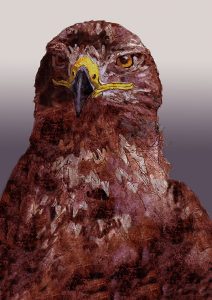The common Buzzard (size approximately 51 – 57 cm) is a medium to large bird of prey. It is now very common in the UK and has taken over from the Kestrel as Britains most prevalent raptor. It resembles the much larger Golden Eagle and in Scotland it is often mistaken for this bird, by tourists, especially when soaring. It is predominately mottled brown in colour especially in the British isles but across its full range (Eurassia) it presents a great deal of variability from almost pure white to black.
Their diet is as variable as their colouring. They are more than capable of catching rabbits, pheasants and other similar size animals but are equally at home scratching for worms and insects on the ground. This varied diet goes some way to account for their success.
On my runs along the Roman road outside Cambridge I have often seen Buzzards flying overhead above the woodlands that grow adjacent to the fields beside the path. They often can be seen in pairs and, at times, in greater numbers particularly in the summer months. In Wales I have observed them soaring in the company of Red Kites the Kite being a partigularly gregarious species. I have also seen them fly from their perches in trees to the ground and then back again repeatedly as they hunt for worms and insects. On one memorable occasion, whilst cycling in the Isle of Wight, a buzzard broke cover form the hedgerow lining the road and flew right across my path. Its sheer size and close proximity was heartstopping.
Buzzards mate for life.
What’s in a name– What makes a raptor a raptor?
Well to start with they are defined as having a hooked beak. This physical characteristic is one way to differentiate them from other birds. All raptors have the same beak designs, curved at the tip with sharp cutting edges.
Birds of prey are also in possession of powerful leg & toe muscles. The length and size of legs & toes have evolved for each raptor in relation to the type of prey captured by that species.
Thirdly all raptors posses excellent sensory perception, hearing (in the case of owls & harriers) and in their vision they have the keenest in the animal kingdom. Nocturnal raptors like owls additionally have excellent night vision. In contrast the night vision of diurnal raptors is no better than that of humans.
The name raptor is derived from “rapere,” a Latin word which means to seize or capture and the diet of these birds is also a distinguishing feature. Birds of prey generally feed on vertebrates and more often quite large prey relative to their own size. They also,to a greater or lesser extent, feed on carrion which forms part of their diet. With the vultures carrion forms the bulk of their food intake.
The female of the species
Finally male to female size disparity. Though not unique to raptors (this is presented in some other bird species) birds of prey exhibit what is know as reversed sexual size dimorphism, that is the female of the species is larger than the male. What is more the more aggressive the species the larger the female. There are a number of theories as to why this size disparity exist. One is that, being bigger, it helps protect the female bird from her more agressive male partner. A more convincing explanation is that this variation in size helps the birds exploit a greater range and scale of prey thus increasing the availability of food sources when raising their young.

